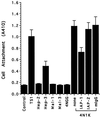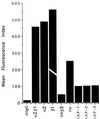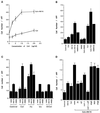The thrombospondin receptor CD47 (IAP) modulates and associates with alpha2 beta1 integrin in vascular smooth muscle cells
- PMID: 9529384
- PMCID: PMC25313
- DOI: 10.1091/mbc.9.4.865
The thrombospondin receptor CD47 (IAP) modulates and associates with alpha2 beta1 integrin in vascular smooth muscle cells
Abstract
The carboxyl-terminal domain of thrombospondin-1 enhances the migration and proliferation of smooth muscle cells. Integrin-associated protein (IAP or CD47) is a receptor for the thrombospondin-1 carboxyl-terminal cell-binding domain and binds the agonist peptide 4N1K (kRFYVVMWKk) from this domain. 4N1K peptide stimulates chemotaxis of both human and rat aortic smooth muscle cells on gelatin-coated filters. The migration on gelatin is specifically blocked by monoclonal antibodies against IAP and a beta1 integrin, rather than alphav beta3 as found previously for 4N1K-stimulated chemotaxis of endothelial cells on gelatin. Both human and rat smooth muscle cells displayed a weak migratory response to soluble type I collagen; however, the presence of 4N1K peptide or intact thrombospondin-1 provoked a synergistic chemotactic response that was partially blocked by antibodies to alpha2 and beta1 integrin subunits and to IAP. A combination of antialpha2 and IAP monoclonal antibodies completely blocked chemotaxis. RGD peptide and antialphav beta3 mAb were without effect. 4N1K and thrombospondin-1 did not augment the chemotactic response of smooth muscle cells to fibronectin, vitronectin, or collagenase-digested type I collagen. Complex formation between alpha2 beta1 and IAP was detected by the coimmunoprecipitation of both alpha2 and beta1 integrin subunits with IAP. These data suggest that IAP can associate with alpha2 beta1 integrin and modulate its function.
Figures






Similar articles
-
Integrin-associated protein stimulates alpha2beta1-dependent chemotaxis via Gi-mediated inhibition of adenylate cyclase and extracellular-regulated kinases.J Cell Biol. 1999 Oct 18;147(2):389-400. doi: 10.1083/jcb.147.2.389. J Cell Biol. 1999. PMID: 10525543 Free PMC article.
-
Integrin-associated protein binding domain of thrombospondin-1 enhances insulin-like growth factor-I receptor signaling in vascular smooth muscle cells.Circ Res. 2003 Nov 14;93(10):925-31. doi: 10.1161/01.RES.0000101754.33652.B7. Epub 2003 Oct 16. Circ Res. 2003. PMID: 14563713
-
Thrombospondin-bound integrin-associated protein (CD47) physically and functionally modifies integrin alphaIIbbeta3 by its extracellular domain.J Biol Chem. 2003 Jul 18;278(29):26655-65. doi: 10.1074/jbc.M302194200. Epub 2003 May 7. J Biol Chem. 2003. PMID: 12736272
-
Integrin-associated protein (CD47) and its ligands.Trends Cell Biol. 2001 Mar;11(3):130-5. doi: 10.1016/s0962-8924(00)01906-1. Trends Cell Biol. 2001. PMID: 11306274 Review.
-
Enhancing cardiovascular dynamics by inhibition of thrombospondin-1/CD47 signaling.Curr Drug Targets. 2008 Oct;9(10):833-41. doi: 10.2174/138945008785909338. Curr Drug Targets. 2008. PMID: 18855617 Free PMC article. Review.
Cited by
-
Epithelial CD47 is critical for mucosal repair in the murine intestine in vivo.Nat Commun. 2019 Nov 1;10(1):5004. doi: 10.1038/s41467-019-12968-y. Nat Commun. 2019. PMID: 31676794 Free PMC article.
-
G alpha 12 inhibits alpha2 beta1 integrin-mediated Madin-Darby canine kidney cell attachment and migration on collagen-I and blocks tubulogenesis.Mol Biol Cell. 2009 Nov;20(21):4596-610. doi: 10.1091/mbc.e09-03-0220. Epub 2009 Sep 23. Mol Biol Cell. 2009. PMID: 19776354 Free PMC article.
-
Simultaneous blocking of CD47 and PD-L1 increases innate and adaptive cancer immune responses and cytokine release.EBioMedicine. 2019 Apr;42:281-295. doi: 10.1016/j.ebiom.2019.03.018. Epub 2019 Mar 14. EBioMedicine. 2019. PMID: 30878596 Free PMC article.
-
Toxoplasma gondii Modulates the Host Cell Responses: An Overview of Apoptosis Pathways.Biomed Res Int. 2019 Apr 4;2019:6152489. doi: 10.1155/2019/6152489. eCollection 2019. Biomed Res Int. 2019. PMID: 31080827 Free PMC article. Review.
-
CD47 and TLR-2 cross-talk regulates neutrophil transmigration.J Immunol. 2009 Nov 1;183(9):5957-63. doi: 10.4049/jimmunol.0900789. Epub 2009 Oct 7. J Immunol. 2009. PMID: 19812191 Free PMC article.
References
-
- Abedi H, Dawes KE, Zachary I. Differential effects of platelet-derived growth factor BB on p125 focal adhesion kinase and paxillin tyrosine phosphorylation and on cell migration in rabbit aortic vascular smooth muscle cells and Swiss 3T3 fibroblasts. J Biol Chem. 1995;270:11367–11376. - PubMed
-
- Adams JC, Tucker RP, Lawler J. The Thrombospondin Gene Family. Austin, TX: R.G. Landes Company; 1995.
-
- Asch AS, Silbiger S, Heimer E, Nachman RL. Thrombospondin sequence motif (CSVTCG) is responsible for CD 36 binding. Biochem Biophys Res Commun. 1992;182:1208–1217. - PubMed
-
- Asch AS. The role of CD 36 as thrombospondin-1 receptor. In: Lahav J, editor. Thrombospondin. Boca Raton, FL: CRC Press; 1993. pp. 265–275.
Publication types
MeSH terms
Substances
LinkOut - more resources
Full Text Sources
Other Literature Sources
Molecular Biology Databases
Research Materials

